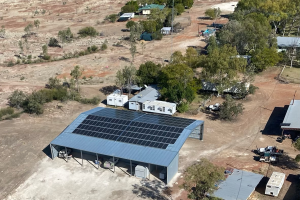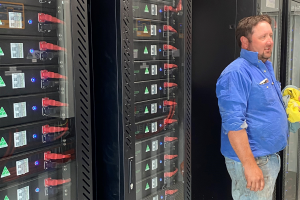The latest NAB Regional & Agribusiness webinar provides insights on the Australian & Global Economies, and a regional and rural property update. Watch the webinar here.


Remote Queensland cattle station invests in a greener future for generations to come with support from NAB Agri Green Loan.

A desire to slash emissions as well as their diesel bill has seen Queensland beef producers Charlie and Jackie Hawkins invest in their most reliable source of renewable energy – solar power.
Charlie and Jackie and their family’s HC Pastoral Company own cattle properties including Herbertvale Station north of Camooweal and Malakoff Downs at Hughenden.
At the 137,000-hectare Herbertvale Station in remote North West Queensland, managed by Clint, Shelly and Dan Hawkins, a large-scale solar project has just been completed to provide self-generating, off-grid power for the station.
The Hawkins utilised NAB’s new Agri Green Loan to finance the installation of the $620,000 solar power system from Q Energy Solutions.

“There is no power grid system available to Herbertvale, so we have always had to generate our own power, and we were using a diesel generator 24/7 to power the station,” Charlie says.
“The diesel was costing us roughly $10,000 a month in summer to run the generator, and in winter about $7,000 a month. We have a lot more summer than winter, so the average was between $9,000 to $10,000 per month. The generator only ever got switched off to be serviced.”
“The station complex is big. It includes three family-sized houses, two cottages, staff quarters to accommodate six people, the workshop, shed, a bore to supply water for the station and to water cattle, and a social area with a pool. One of the houses has a staff kitchen large enough to cater for 20 people, and there are cold rooms attached to the houses as well.”
The new system comprises 200 solar panels which have been installed on the roof of a new 31.5m x 18m machinery shed which cost approximately $120,000.
Charlie says while the initial outlay for the solar and shed was significant, the benefits have been immediate and will continue for generations, with the system offsetting an average of just over 275kg/day of C02 so far.
“The Agri Green Loan repayments per month are less than what the diesel was costing us. In seven years’ time, the system will be totally paid for by the savings in diesel,” Charlie says.

“I spent a lot of time researching the right system for us and this one is extremely well-designed. Under the new shed there is a concrete bay with a dust-free air-conditioned container for the rechargeable solar batteries. It is set at a constant temperature of 24°C, to help the life of the batteries.”
“In the next bay is a generator that came with the system. That generator automatically starts up if the batteries get to less than 38% and will fully charge the batteries in three hours.”
“The maximum amount of diesel we will use for power generation now will be three hours a day, instead of 24 hours a day.”
“The 80kVA industrial diesel generator that previously powered the station was only three years old. It has been set up as a back-up, so it can take over the whole system if there is any failure at all.”
The solar project is a further extension of the Hawkins’ existing use of solar to power a number of bores for stock water across their properties.
“Malakoff Downs, managed by Bill and Bec Hawkins, which is smaller in terms of the station infrastructure, has been on solar now for about two years, but it’s part of the grid system. It reduced our power bill by 80-85%,” Charlie says.
“It’s good having the two systems to compare and contrast. One is producing power into the grid and we’re drawing back out, and the other is a standalone, self-sustaining system.”
“I think it’s very exciting. We wanted to do better in the carbon and renewables space, and in the bush we have relied on renewables in the past in the form of wind to pump water, but now we’re using another renewable in the sun, which is certainly a lot more reliable in this part of Australia.”
“One of the many good things about the Green Loan is that it secures itself really, and that’s very attractive for the bush.”
“If you were to build or buy anything else for your property to the same value as this system, you wouldn’t get the same saving.”
© National Australia Bank Limited. ABN 12 004 044 937 AFSL and Australian Credit Licence 230686.